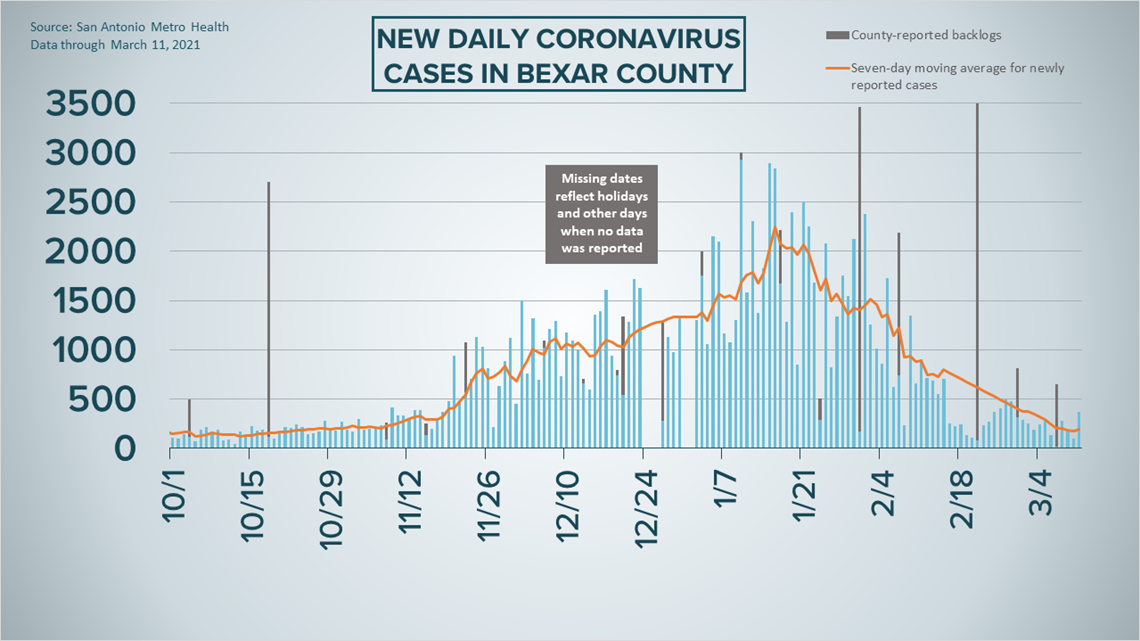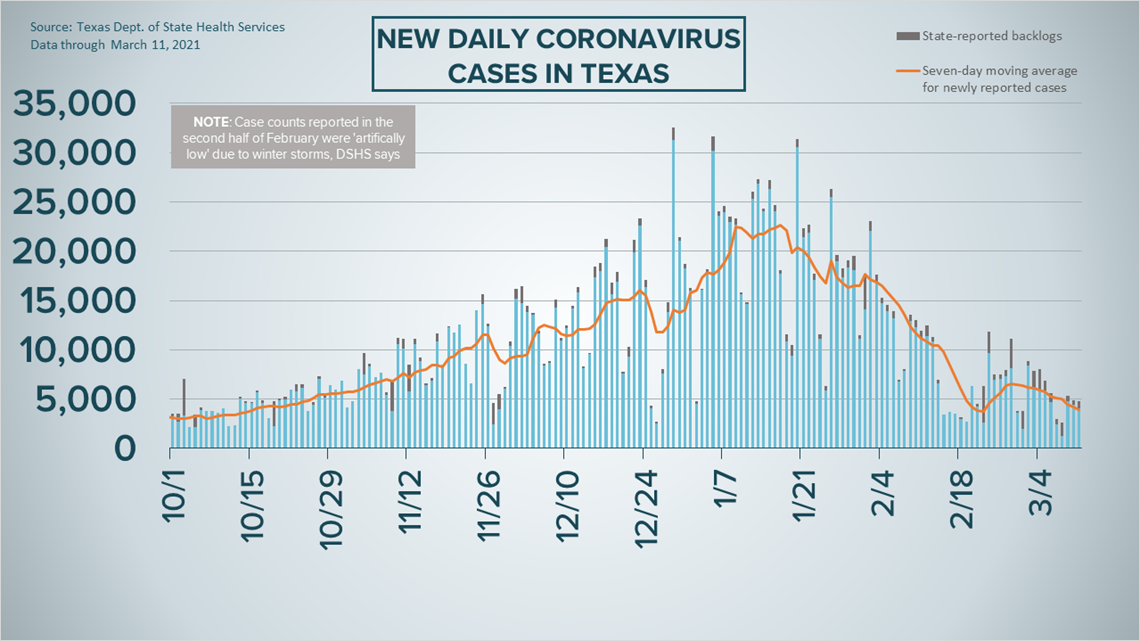SAN ANTONIO — We're tracking the latest numbers from the coronavirus pandemic in San Antonio and across Texas. Here are the latest numbers reported by Bexar and surrounding counties:
- Bexar County: On Thursday, 366 new cases were reported, bringing the total number of cases to 199,431. Five new deaths were also reported, raising the local death toll from virus complications to 2,861.
- Hays County: On Thursday, officials reported 36 new cases in the county and two additional COVID-related fatalities. There is now a total of 16,651 lab-confirmed local cases, while the death toll increased to 231. Officials estimate 15,947 residents have recovered, while 473 are still ill with the virus.
- Comal County: Officials reported 12 new cases on Thursday, along with no additional virus-related deaths. As of Thursday, 9,380 total COVID-19 cases have been reported, including 4,943 confirmed and 4,416 probable cases, while 298 county residents have died due to COVID-19 complications.
More county case information is available through the Texas Department of Health Services COVID-19 dashboard.
How Bexar County is trending
We've tracked how many coronavirus cases have been confirmed in Bexar County from the time officials began reporting cases in March 2020. The graphic below shows the number of cases since June and charts those daily case numbers along a 7-day moving average to provide a more accurate picture of the overall coronavirus case curve in our area and the direction we're trending amid the pandemic.
On Thursday, San Antonio Mayor Ron Nirenberg reported an additional 366 coronavirus cases in Bexar County, the largest single-day count since Feb. 27. The tally raises the local case total to 199,431 since the pandemic began. The seven-day rolling case average also saw a slight bump with the high case count; it increased from 173 to 186.
Nirenberg also reported five new deaths from coronavirus complications. In all, 2,861 Bexar County residents have died from COVID-19.


Despite the higher case count, hospitalizations continued to go down Thursday. In all, there are 240 COVID-19 patients at area hospitals, which is down 10 from Wednesday. November 3 was the last time the local hospitalizations number was that low.
Of those 240 currently hospitalized, 63 are using ventilators and 104 are in intensive care.


Coronavirus in Texas
The total number of novel coronavirus cases in the state since the pandemic began grew by 4,755 on Thursday, according to the Texas Department of State Health Services. That total includes 3,032 new confirmed cases, 1,021 new probable cases, and a backlog of 702 cases. More details can be found on this page.
Thursday's figures bring the total number of Texans diagnosed with COVID-19 to more than 2.704 million.


Meanwhile, state health authorities reported an additional 231 deaths from coronavirus complications in Texas. In all, 45,106 Texans have died from COVID-19.
Following a drastic jump in statewide hospitalizations Tuesday, the number has decreased for the second day in a row, this time by 150 to 4,406 COVID-19 patients receiving treatment for their symptoms across the state, as of Thursday.
The state, meanwhile, estimates that about 2.534 million Texans have recovered, while 121,822 Texans remain ill with COVID-19.
The latest update from the Texas Education Agency showed that there have been at least 190,308 cumulative cases among staff and students on Texas public school campuses through Feb. 28. That number comprises 123,875 positive student cases and 66,433 staff cases. More information can be found here.
The TEA typically releases new data on school cases on Fridays.
Latest Coronavirus Headlines
- VERIFY: COVID-19 vaccines for zoo animals have no impact on human shot distribution
- President Biden signs $1.9T coronavirus relief bill before speech to nation
- Vaccine update: Phase 1C begins in Texas on March 15 — here's who is eligible
- Expanded eligibility, stagnant supply: San Antonio-area leaders frustrated over limited vaccine doses
- Four former presidents, first ladies urge Americans to get COVID vaccine in PSA
- Leftover COVID vaccines: Website will alert you when nearby clinics have extra doses going to waste
- One year later: How life has changed since the COVID-19 pandemic
- Key moments that defined the first year of the COVID-19 pandemic
- Mays Cancer Center studying effects of COVID-19 vaccine on patients
Coronavirus symptoms
The symptoms of coronavirus can be similar to the flu or a bad cold. Symptoms include fever or chills, cough, shortness of breath or difficulty breathing, fatigue, muscle or body aches, headache, new loss of taste or smell sore throat, congestion or runny nose, nausea or vomiting, and diarrhea, according to the Centers for Disease Control.
Most healthy people will have mild symptoms. A study of more than 72,000 patients by the Centers for Disease Control in China showed 80 percent of the cases there were mild.
But infections can cause pneumonia, severe acute respiratory syndrome, kidney failure, and even death, according to the World Health Organization. Older people with underlying health conditions are most at risk.
Experts determined there was consistent evidence these conditions increase a person's risk, regardless of age:
- Chronic kidney disease
- COPD (chronic obstructive pulmonary disease)
- Obesity (BMI of 30 or higher)
- Immunocompromised state (weakened immune system) from solid organ transplant
- Serious heart conditions, such as heart failure, coronary artery disease, or cardiomyopathies
- Sickle cell disease
- Type 2 diabetes
The CDC believes symptoms may appear anywhere from two to 14 days after being exposed.
Human coronaviruses are usually spread...
- Between people who are in close contact with one another (within about 6 feet).
- Through respiratory droplets produced when an infected person coughs, sneezes or talks. These droplets can land in the mouths or noses of people who are nearby or possibly be inhaled into the lungs.
- Some recent studies have suggested that COVID-19 may be spread by people who are not showing symptoms.
Help stop the spread of coronavirus
- Stay home when you are sick.
- Eat and sleep separately from your family members
- Use different utensils and dishes
- Cover your cough or sneeze with your arm, not your hand.
- If you use a tissue, throw it in the trash.
Find a Testing Location
City officials recommend getting a COVID-19 test if you experience fever or chills, cough, shortness of breath or difficulty breathing, fatigue, muscle or body aches, headache, new loss of taste or smell, sore throat, congestion or runny nose, nausea or vomiting, or diarrhea.
A self-screening tool is available to see if you need a test.
Here's a Testing Sites Locator to help you find the testing location closest to you in San Antonio.



